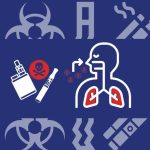
“Dirty Ashtray” smears Philippines’ good reputation in public health
April 26, 2024
Revealing the Truth Behind the Lies on ENDS and HTPs
June 21, 2024From the age of sixteen, Vince Limuel Lamson, had been hooked on vape. He recalled puffing assorted flavors and vapor with friends any time of the day for the last seven years. It was after figuring in an accident in 2021 that he had to undergo a chest x-ray. This revealed the horrifying state of his lungs.
“Nagulat ‘yong mga doktor. Sobrang lakas ko raw bang manigarilyo. Hindi naman daw sunog ‘yong baga ko. Saan ko daw nakuha ‘yon. Napailing na lang sila na sa vape ko daw nakuha ‘yong gano’ng baga na sobrang itim, punung-puno ng plema na kulay itim, tapos mga liquid na kulay itim, tapos may mga usok, basta sobrang dumi dahil sa vaping,” Lamson said.
“Hindi dapat ako nakiuso at nag-vape lang. Naging astig ka nga, ilang araw lang, ilang buwan llang, pero pagbabayaran mo ‘yon kapag na-ospital ka,” Lamson advised young people while struggling to catch his breath due to the injury caused to his lungs.
In a press briefing in time for World No Tobacco Day, with this year’s theme, “Protecting Children from Tobacco Industry Interference #TobaccoExposed,” the Philippine Pediatric Society’s Tobacco and Nicotine Control Advocacy Group warned that more children are at risk of developing e-cigarette or vape-use associated lung injury (EVALI) in the coming years because vape products have become more accessible in many parts of the country. At present, only one case of EVALI has been confirmed by the Department of Health in the Philippines in 2019, which involved a 16-year-old girl from the Visayas.
“We cannot allow the vape addiction to worsen or let an EVALI crisis happen in our country especially among young Filipinos. That is why we should not stop educating our children on the health dangers of vapes and continue debunking widespread misinformation. Vapes are not harmless nor is it a safer substitute to tobacco. They contain nicotine and other toxic substances that affect the heart and brain development of children, as well as other chemicals that are carcinogenic or cancer-causing like that of tobacco,” explained Dr. Rizalina Gonzalez, Chairperson of the Philippine Pediatric Society’s Tobacco and Nicotine Control Advocacy Group.
Hence, youth-oriented health advocate groups Child Rights Network (CRN) and the Philippine Smoke-Free Movement Youth (PSFM-Youth) argued that the tobacco industry’s devious tactics enticing children to smoke and vape must be stopped.
“The tobacco industry is blatantly peddling their harmful tobacco and vape products in their ploy to prey on our children as their youngest and long-term clientele that will keep their business alive and stuff their pockets full of profit. They even tap social media and other online influencers or vloggers to promote smoking and vaping that harm the health and jeopardize the future of the Filipino youth,” said Roi Vincent Merca, advocacy officer of the Philippine Legislators’ Committee on Population and Development, and convenor and cluster lead for the Tobacco-free Generation Campaign of the Child Rights Network.
Von Vladimir L. Defuntorum of PSFM-Youth also added, “Our youth leaders and other youth-led organizations should unite and join the fight against this vapedemic. Let’s help raise awareness to our fellow young people so they may not fall for the trap and lies that tobacco companies fabricate. We also implore social media personalities to use their network of avid followers to spread good influence and set good examples that will lead young people away from smoking or vaping.”
In addition, public health advocacy group HealthJustice expressed fears that a grim future could befall the youth if policymakers refuse to act with a sense of urgency to stop the proliferation of e-cigarettes or vapes that are becoming more and more easily available.
“While tobacco use, like traditional cigarettes, has decreased, vape use, however, appears to have increased in the past five years, especially among children. Thus, we demand that our policymakers take swift action now to prevent harming the health of our future generation. In fact, they should revisit and amend the watered-down Vape Regulation Law. Otherwise, the possible repercussions of youth addiction could be worse in the next three to five years,” said Atty. Benedict Nisperos, legal consultant of HealthJustice.
Data from the last Global Youth Tobacco Survey (GYTS) of 2019 showed that Filipino adolescents aged 13 to 15 years who have used vapes more than doubled to 1.6 million from about 740,000 in 2015. While adolescents who smoked tobacco have decreased by 10% to 800,000 from 1.3 million in 2007.



